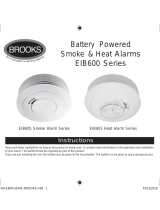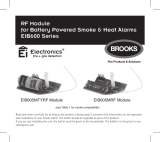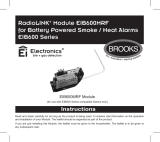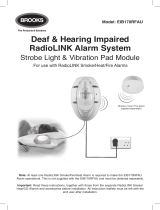Page is loading ...

Instructions
Read and retain carefully for as long as the product is being used. It contains vital information on the operation and installation
of your Smoke Alarm. The leaflet should be regarded as part of the product.
If you are just installing the unit, the leaftet must be given to the householder. The leaflet is to be given to any subsequent user.
Ei605MTYRF Module Ei605MRF Module
RF Modules
for Battery Powered
Smoke & Heat Alarms
Ei600 Series
B16971-R0-Ei600 RF-U&C 28/6/10 12:13 PM Page 1

Introduction
Congratulations on purchasing an Ei600 Series RF RadioLINK module. These RF
modules can be easily installed in the Ei600 Series Alarm to provide you with an RF
interconnected fire warning system – when one Alarm senses fire and sounds a
warning, all the other Alarms will also sound a warning. This helps to ensure the
alarm sound will be heard throughout the property.
Installation
1. The Ei600 Series Alarm must be installed as per the guidance in the instruction
booklet ‘Battery Powered Smoke & Heat Alarms’.
2. Remove the RF module from the packaging and using the pull tag, carefully
insert into the back of the Alarm (see figure 1) - (some Alarm models may have the
RF Module already fitted).
3. Ensure that the battery is connected in the 9V Replaceable Battery Models.
House code the Alarms as follows:
4. Before fitting the Alarm to the mounting plate, press and hold the ‘House Code’
switch on the rear of the RadioLINK module until the red light comes on (see
Figures 2a) and then release.
5. Twist the Alarm onto its mounting plate.
6. Similarly press and hold the House Code switch on the second Alarm until its red
light comes on and then release. Twist the Alarm onto its mounting plate. Put all the
remaining alarms into House Code mode similarly and attach to the mounting plate
in the same manner in less than 15 minutes. (They automatically exit house code
mode after 30 minutes).
2
B16971-R0-Ei600 RF-U&C 28/6/10 12:13 PM Page 2

7. When in the House Code mode, the blue light (on the front of the Alarm - see
figure 2b) will flash a number of times every 5 seconds to indicate:
(a) that the Alarm is in House Code mode,
and
(b) the number of Alarms that have been identified and added to your system.
For example with 3 Alarms in your system, you should see 3 blue light flashes every
5 seconds, with 4 Alarms in your system you should see 4 blue light flashes and so
on, (with the 10th unit, the blue flash is longer, to help with the counting).
Check that the number of blue light flashes corresponds to the number of Alarms in
the system. If not see the “RadioLINK Troubleshooting” section below.
3
INSERT RF MODULE BY PLUGGING IN PINS & ALSO INSERT ITS
ANTENNA IN THE HOLE PROVIDED - HOLD BY PULL TAG
PULL TAG
ANTENNA
HOLE
ANTENNA
LED
Figure 1
B16971-R0-Ei600 RF-U&C 28/6/10 12:13 PM Page 3

8. The Alarms will stay in House Code mode for 30 minutes and then reset
automatically. Alternatively they can be taken out of House Code mode by removing
one Alarm from its mounting plate and quickly pressing and holding the House
Code switch until the red light comes on solidly again. Release the switch and the
red light will go out immediately, indicating that the Alarm is no longer in House
Code mode. Replace the Alarm on the mounting plate. The blue light will no longer
be flashing.
Note: As this Alarm exits house code mode it sends a radio message to all the
other Alarms to exit the house code mode. Check that all the blue lights on the rest
of the Alarms have ceased flashing. (Accessories must be taken out of house code
manually - see their instructions).
9. Button test all Alarms in turn and check all the other Alarms are sounding at the
same time. If they are not all communicating see section below “RadioLINK
Troubleshooting”.
4
BLUE LIGHT
RED LIGHT
HOUSECODE
SWITCH
Figure 2a
Figure 2b
B16971-R0-Ei600 RF-U&C 28/6/10 12:13 PM Page 4

5
Additional RadioLINK Alarms can be added to the system at any time. Simply put all
the Alarms into the House Code mode at the same time and again check the number
of blue light flashes on each Alarm.
RadioLINK
Troubleshooting
It is imperative that all Alarms in your system communicate with each other. The
number of walls, ceilings and metal objects in the signal path reduces the strength of
the RadioLINK signals between the Alarms. Accordingly, one or more Smoke / Heat
Alarms may have difficulties in communicating to all the other Alarms in the system.
If, when checking the RadioLINK interconnection, some of the Alarms do not
respond to the button test, then you will need to either:
(i) Position another RadioLINK Alarm to act as a ‘repeater’ (see Interconnection with
RadioLINK Modules below) between the units which are not communicating and so
EXTEND ANTENNA
VERTICALLY
CUT OUT NOTCHES
ON ALARM &
MOUNTING PLATE
EXTEND ANTENNA
HORIZONTALLY
Figure 3
B16971-R0-Ei600 RF-U&C 28/6/10 12:13 PM Page 5

shorten the path and/or by-pass an obstacle which is blocking the signal. When the
new Alarm is fitted, house code all Alarms again, as described above.
(ii) Remove the module and extend the antenna vertically (or horizontally) as
shown in figure 3. (For maximum RF signal strength orientate all the antennas in the
same direction - see Figure 4).
(iii) rotate / re-locate the units (e.g. move them away from metal surfaces or wiring).
After making these changes to the RF signal path, the RadioLINK signals may still
not be reaching all the Alarms in your system, even though they have already been
House Coded successfully. (see Section on “RadioLINK Limitations”).
6
Large
hole
nearest
front
wall
Orientate all
mounting plates
in the same
direction
Front Wall Front Wall
Mounting Plate Mounting Plate
Mounting Plate
Mounting Plate
Figure 4
B16971-R0-Ei600 RF-U&C 28/6/10 12:13 PM Page 6

It is important to check that all Alarms are communicating in their final installed
positions. If Alarms are rotated, have had their antennas extended and/or resited,
we would recommend that all the Alarms are returned to the factory settings and
then House Coded again in their final positions (see above). The RadioLINK
interconnection should then be checked again by button testing all units.
(Note: The RadioLINK module can be returned to the originally factory settings by
pressing and holding the House Code switch on until the red light turns on solidly
and then flashes slowly. This will take about 10 seconds. This clears the House
Codes that have been learnt).
Interconnection with RadioLINK Modules
A combined maximum of 12 Alarms with RF RadioLINK Modules may be
interconnected so that if one of the Alarms senses fire, and sounds a warning, all
the other Alarms will also sound a warning. This helps to ensure the alarm will be
heard throughout the property.
As a safety feature, the Alarms as supplied, will all communicate with each other using
the default RF signal. However, to avoid other neighbouring systems setting off your
Alarms and vice versa, we recommend that you “House Code” your Alarm system.
Another very important reason for house coding is that after the Alarms are house
coded, they all act as “repeaters” i.e. they repeat the messages from other Alarms
and so greatly improve the reliability and range of the radio communication.
Note: These Alarms should be interconnected only within the confines of a single
family living residence. If they are connected between different residences there
may be excessive nuisance alarms. Everybody may not be aware that they are
being tested or that it is a nuisance alarm caused by cooking etc.
7
B16971-R0-Ei600 RF-U&C 28/6/10 12:13 PM Page 7

Depending on the Alarm models you purchased, the RadioLINK module may have
been supplied with the unit or you may have to purchase it separately.
When fitting or removing the RadioLINK module, please hold using the pull tab
attached to it. Also tuck the tab between the Alarm housing and the module when
it is installed in order to avoid it being fouled up with the mounting plate.
Testing
Your Alarm is a life saving device and should be checked periodically. Regularly
check that the red light on the Alarm flashes approx once a minute to show the units
are powered. Replace the Alarm if the flashing stops.
Manually Testing your Alarms
It is recommended that you test your Alarms after installation and then at least
weekly to ensure the units are working. It will also help you and your family to
become familiar with the sound of the Alarms.
- Press and hold the Test Button until the Alarm sounds and the red light flashes
The Alarm will stop sounding shortly after the button is released.
- If they are interconnected using RadioLINK modules, hold down the Test button until
the blue light on the cover of the Alarm illuminates. Check that all other Alarms sound.
- Release the Test button. The Alarm and all connected Alarms should stop
sounding.
- Repeat this procedure for all other Alarms in the system.
WARNING: Do not test with flame.
8
B16971-R0-Ei600 RF-U&C 28/6/10 12:13 PM Page 8

RadioLINK Limitations
Limitations of RadioLINK Radio Frequency Signals
Ei Electronics radio communication systems are very reliable and are tested to high
standards. However, due to their low transmitting power and limited range (required
by regulatory bodies) there are some limitations to be considered:
(i) Receivers may be blocked by radio signals occurring on or near their operating
frequencies, regardless of the House Coding.
(ii) Alarms with RadioLINK modules should be tested regularly, at least weekly. This
is to determine whether there are sources of interference preventing
communication, that the radio paths have not been disrupted by moving furniture or
renovations, and if so, to give a warning of these and other faults.
Getting Your Alarm Serviced
If your Alarm fails to work after you have read the sections on “Installation”, “Testing
and Maintenance” and “Troubleshooting”, then contact Customer Assistance at the
nearest address given at the end of this leaflet. If it needs to be returned for repair
or replacement put it in a padded box with the battery disconnected (9V
Replaceable Battery models only). The 10 Year Lithium Battery models must be
removed from the mounting plate. Send it to “Customer Assistance” at the nearest
address given on the Alarm or in this leaflet. State the nature of the fault, where the
Alarm was purchased and the date of purchase.
9
B16971-R0-Ei600 RF-U&C 28/6/10 12:13 PM Page 9

Five Year Guarantee
Ei Electronics guarantees this RF RadioLINK Module for five years from date of
purchase against any defects that are due to faulty materials or workmanship. This
guarantee only applies to normal conditions of use and service, and does not
include damage resulting from accident, neglect, misuse, unauthorised dismantling,
or contamination howsoever caused. This guarantee excludes incidental and
consequential damage. If this RF RadioLINK Module should become defective
within the guarantee period, it must be returned to Ei Electronics, with proof of
purchase, carefully packaged, with the problem clearly stated. We shall at our
discretion repair or replace the faulty unit.
Do not interfere with the Alarm or attempt to tamper with it. This will invalidate the
guarantee, but more importantly may expose the user to shock or fire hazards.
This guarantee is in addition to your statutory rights as a consumer.
10
The crossed out wheelie bin symbol that is on your
product indicates that this product should not be disposed
of via the normal household waste stream. Proper
disposal will prevent possible harm to the environment or
to human health. When disposing of this product please
separate it from other waste streams to ensure that it can
be recycled in an environmentally sound manner. For
more details on collection and proper disposal, please
contact your local government office or the retailer where
you purchased this product.
B16971-R0-Ei600 RF-U&C 28/6/10 12:13 PM Page 10

11
B16971-R0-Ei600 RF-U&C 28/6/10 12:13 PM Page 11

Aico Ltd. Mile End Business Park, Maesbury Rd, Oswestry,
Shropshire SY10 8NN, U.K.
Tel: 0870 758 4000
www.aico.co.uk
Ei Electronics. Shannon, Co Clare, Ireland. Tel: 061 471277
www.eielectronics.com
P/N B16971 Rev 0© Ei Electronics 2010
B16971-R0-Ei600 RF-U&C 28/6/10 12:13 PM Page 12
/





